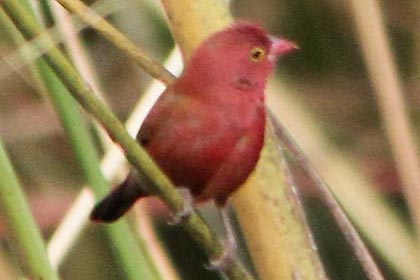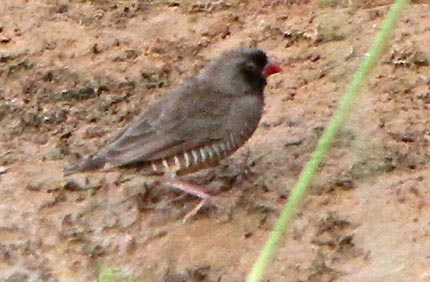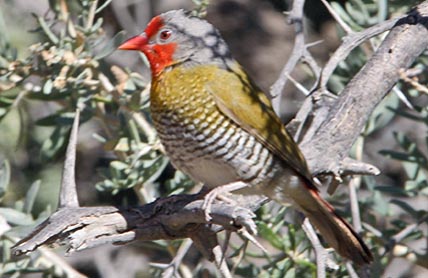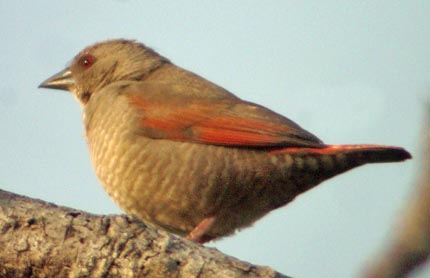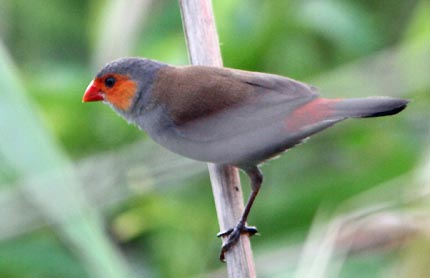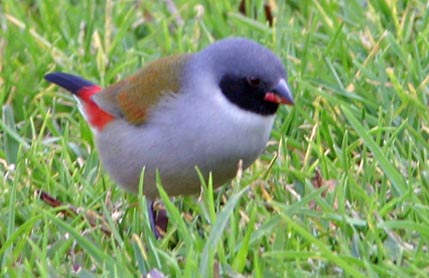
a web page by Don Roberson |
ESTRILDID FINCHES Estrildidae Waxbills, Munias & Allies |
||||||||
|
||||||||
 |
||||||||
The Zebra Finch (left, a male & female together at Alice Springs, photo'd by Murray Lord), is another colorful Australian species, but much more widespread in open grasslands across the continent. It has become a favorite of aviculturalists and can be easily bred in captivity. Orange-cheeked male Zebra Finch are easily distinguished from females, but in Diamond Firetail (below, a David Bishop shot from his backyard) the sexes are similar. It is a species of open eucalypt woodlands, mallee bush, and gardens of southeastern Australia. According to Payne (2010b), all these finches are "grassfinches" in subfamily Lonchurinae. |
||||||||
|
||||||||
|
||||||||
The other part of subfamily Lonchurinae are the munias and mannikins — a set of estrildids centered in southeast Asia but also widely distributed in Africa. Chestnut Munia (right) is an exceptionally widespread and common species of grasslands, gardens, and rice paddies in southern Asia – from India through the Greater Sundas to Sulawesi. The range of Bronze Mannikin (below) is equally wide in sub-Saharan Africa.
Both Chestnut Munia and Bronze Mannikin are so adaptable that they have been widely introduced. Non-native populations of the munia exist in Japan, Palau Is., Hawaiian Is., and Jamaica (to name just a few locales) while non-native Bronze Mannikins can be found in Hawaii and Puerto Rico. [The common name "mannikin" for a number of the African species (and a few in Asia also) is unfortunate. It is a source of confusion for beginners with the suboscine manakins of the New World — completely unrelated birds — but it is so embedded in the field guides at this point that there seems nothing can be done about it.] Although there are some very common munias and mannikins, quite a number of the Lonchurinae are endemic to single islands, and can be scarce and local. Madagascar Munia (below left) is found only on Madagascar, but there it is widespread [Payne (2010b) uses the name "Madagascar Bibfinch for this species, and places it in the monotypic genus Lepidopygia]. In contrast, Black-breasted Mannikin (below right) is restricted entirely to the Baliem Valley (or Grand Valley) of the Snow Mountains of Indonesian New Guinea, where it prefers mid-montane grasslands from 1200-2200m [4000-7200' elev.]. |
||||||||
|
||||||||
The one species that occurs on the southeast Asian mainland is Pin-tailed Parrotfinch (right). Here the colorful male (far right) hides in the shadows while the plain-green, buff-bellied female (near right) works on eating bamboo seeds within the thicket. Many parrotbills are rare, elusive, and restricted to endemic islands. Red-throated Parrotbill (below, a male) is found only on New Caledonia. |
||||||||
 |
||||||||
 |
||||||||
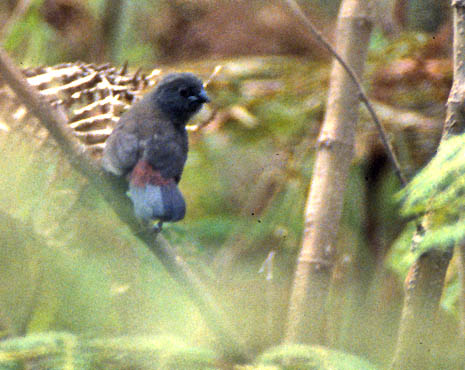 The
final subfamily in the Estrildidae is the Estrildinae — the "typical
waxbills" (Payne 2010b). There are at least 70 species in 20 genera,
and a high percentage are from Africa. Some of them are far from
"typical." Members of this subfamily range through a wide variety of
habitats. The four species of Nigrita (genus Nigrita) are forest birds. This Gray-capped Nigrita (above) is high in the canopy of primary forest in Ghana. The three species of Antpecker (genus Parmoptila) are secretive birds of the forest floor and understory, feasting on arboreal ants. The three species of seedcrackers (genus Pyrenestes) and three species of bluebills (genus Spermophaga) are reclusive forest understory birds. The four species of crimsonwing (genus Cryptospiza)
are shy residents of montane forests, The four species of twinspots, in
two genera, prefer grassy areas within woodland. These can be quite
patchy in occurrence. This is Dusky Twinspot (right)
has a widely disjunct range: it occurs in Angola and then, separated by
the continent, in the highland of the Albertine Rift from DR Congo to
Uganda. The
final subfamily in the Estrildidae is the Estrildinae — the "typical
waxbills" (Payne 2010b). There are at least 70 species in 20 genera,
and a high percentage are from Africa. Some of them are far from
"typical." Members of this subfamily range through a wide variety of
habitats. The four species of Nigrita (genus Nigrita) are forest birds. This Gray-capped Nigrita (above) is high in the canopy of primary forest in Ghana. The three species of Antpecker (genus Parmoptila) are secretive birds of the forest floor and understory, feasting on arboreal ants. The three species of seedcrackers (genus Pyrenestes) and three species of bluebills (genus Spermophaga) are reclusive forest understory birds. The four species of crimsonwing (genus Cryptospiza)
are shy residents of montane forests, The four species of twinspots, in
two genera, prefer grassy areas within woodland. These can be quite
patchy in occurrence. This is Dusky Twinspot (right)
has a widely disjunct range: it occurs in Angola and then, separated by
the continent, in the highland of the Albertine Rift from DR Congo to
Uganda. |
||||||||
A female and young Violet-eared Waxbill are shown below: |
||||||||
 |
||||||||
|
||||||||
Beyond the wide diversity of colors, patterns, plumages, and habitats of the estrildids of Africa, what makes them particularly interesting is the co-evolution of a fair number of finches — waxbills, firefinches, pytilias, quailfinches, and even some twinspots —with the parasitic members of the Viduidae, the Whydahs and Indigobirds. Much of what follows is taken from my Whydahs web page: "All members of the Viduidae are brood parasites. They evolved from small finch-like ancestors and diverged into two families about 20 million years ago: the Estrildidae and the Viduidae. In short, within one evolutionary clade, some species began to parasitize their close relatives by laying eggs in the relative's nest and having the relative raise the young — quite an amazing biological adaptation. The two 'types' of small birds — one parasitic and one the unwitting host — have followed separate evolutionary paths for 20 million years (summary in Payne 2010a)." |
||||||||
Each species parasitizes specific hosts. Village Indigobird, for example, primarily parasitizes Red-billed Firefinch Lagonosticta senegala (although will parasitize other firefinches in some circumstances) and does so by mimicking the song of the host species. The male attracts females with singing and hovering displays. After mating, females lay eggs that mimic the color of the host's eggs (a female may even remove some firefinch eggs). When the young indigobirds hatch, they beg with open mouths that have the same pattern of spots as those inside the mouth as the host's young. By these subterfuges, each generation of indigobird is raised entirely by their hosts. Wilson's Indigobird Vidua wilsoni parasitizes Bar-breasted Firefinch Lagonosticta rufpictua; Quailfinch Indigobird V. nigeriae parasitizes Black-faced Quailfinch Ortygospiza atricollis; Jos Plateau Indigobird V. maryae (an endemic northern Nigeria and n. Cameroon) parasitizes Rock Firefinch Lagonosticta sanguinodorsalis; Jambandu Indigobird V. raricola (with very patchy distribution) parasitizes Zebra Waxbill Amandava subfalva; Barka Indigobird V. larvaticola parasitizes Black-faced Firefinch Lagonosticta larvata; Cameroon Indigobird V. camerunensis parasitizes several scarce hosts species [African Firefinch L. rubricata in north Africa plus Black-bellied Firefinch L. rara, Brown Twinspot Clytospiza monteiri, and Dybrowski's Twinspot Euschistospiza dybowskii]; Dusky Indigobird V. funerea parasitizes African Firefinch L. rubricata in south & east Africa); Purple Indigobird V. purpurascens parasitizes Jameson's Firefinch L. rhodopareia; and Green Indigobird V. codringtoni parasitizes mostly Peter's Twinspot Hypargos niveoguttatus. Of course it is not quite this simple, and cases of "host switching" and probable hybridization are known; for much more see Payne (1973, 2005, 2010). |
||||||||
|
||||||||
The paradise-whydahs also have specific hosts. The widespread Eastern Paradise-Whydah V. paradisaea focuses primarily on Green-winged Pytilia (Melba Finch) Pytilia melba, although apparently may sometimes also parasitize various cordon-bleus Uraeginthus. The Sahel Paradise-Whydah V. orientalis also uses Melba Finch as its host. Broad-tailed Paradise-Whydah V. obtusa parasitizes Orange-winged Pytilia P. afra; Exclamatory Paradise-Whydah V. interjecta parasitizes Red-winged Pytilia P. phoenicoptera; and Togo Paradise-Whydah V. togoensis presumably parasitizes Yellow-winged Pytilia P. hypogrammica. In short, paradise-whydahs chose nesting pytilias as hosts. The hosts of Pin-tailed Whydah V. amcroura are primarily waxbills. Quite a number of species have been identified as hosts, but those species frequently filling the role of parent include Common Waxbill Estrilda astrild, Orange-cheeked Waxbill E. meloda, Fawn-breasted Waxbill E. paludicola, and Black-rumped Waxbill E. troglodytes. In southern Africa, the primary hosts are Common Waxbill and Swee Waxbill Coccopgyia melanotis. |
||||||||
|
||||||||
The remaining three whydahs are Steel-blue Whydah Vidua hypocherina and Straw-tailed Whydah V. fischeri — both from the Horn of Africa region — and Shaft-tailed Whydah V. regia of thornscrub and acacia savanna in and around the Kalahari Desert region of southern Africa. Steel-blue Whydah parasitizes Black-faced Waxbill E. erythronotos. Shaft-tailed Whydah uses Black-faced Waxbill, but also Violet-eared Waxbill Granatina granatina and Blue Cordonbleu Uraeginthus angolensis. The hosts of Straw-tailed Whydah are Blue-capped Cordonbleu U. cyanocephalus and Purple Grenadier Granatina ianthinogaster. Despite the long evolutionary history of brood-parasitism on estrildid hosts, there does not seem to be an impact on populations of the host finches. In many places both whydahs and their hosts remain stable and reasonably common. |
||||||||
Photos: The Painted Finch Emblema pictum — both the group shot and the male close-up —were at Ormsted Gorge in Northern Territories, Australia, on 17 Aug 2008. David Bishop shot the pair of Diamond Firetail Stagonopleura guttata in his garden at Armadale, NSW, Australia. Murray Lord photographed the Plum-headed Finch Neochmia modesta at Bowra Station, Qld., Australia, in Sep 2010. The Double-barred Finch Taeniopygia bichenovii was near Mt. Carbine, Qld., Australia, in Jan 1998. The Chestnut Munia Lonchura atricapilla was on Sulawesi, Indonesia, on 6 Oct 2011. The Bronze Mannikin Spermestes cucullata was at the Narcia wetlands, Ghana, on 6 Dec 2013. The Madagascar Munia Lonchura nana was at Perinet Reserve on 2 Dec 1992. The flock of Black-breasted Mannikin Lonchura teerinki were in the Baliem Valley, Papua, Indonesia, on 31 July 1994. The Pin-tailed Parrotfinch Erythrura prasina was at on 23 Dec 2012. The Red-throated Parrotfinch E. psittacea was at Parc de la Rivière Bleue, New Caledonia, on 9 Jan 1998. The Gray-capped Nigrita Nigrita canicapillus was photographed from the canopy walkway at Kakum NP, Ghana, on 2 Dec 2013. The Dusky Twinspot Euschistospiza cinereovinacea was near Ruhiza in the mountains of Bwindi-Inpenetrable Forest NP, Uganda. The male Red-headed Finch Amadina erythrocephala was in Gemsbok-Kalahari NP, South Africa, on 11 July 2005. The photos of Violet-eared Waxbill Granatina granatina are from Spitzkoppe, Namibia, on 17 July 2005. The male Blue-capped Cordon-bleu Uraeginthus cyanocephalus was at Ndutu, Tanzania, on 10 Aug 2002, as was the male Cut-throat Finch Amadina fasciata. The female Red-cheeked Cordon-bleu Uraeginthus bengalus was near Sapalinga, Ghana, on 15 Dec 2013. The various estrildid host species shown are: a male Red-billed Firefinch Lagonosticta senegala and a male Black-faced Quailfinch Ortygospiza atricollis, both from Nasia River overflow wetlands, Ghana, on 16 Dec 2013; a female Green-winged Pytilia Pytilia melba from Waterburg NP, Namibia, in July 2005, and a female Red-winged Pytilia P. phoenicoptera from Mole NP, Ghana, on 12 Dec 2013; a male Orange-cheeked Waxbill Estrilid melodia from near Kakum NP, Ghana, on 1 Dec 2013; and a male Swee Waxbill Coccopgyia melanotis from the Kirstenbosch Gardens, Cape Town, South Africa, on 3 July 2005. Uncredited photos © Don Roberson. Credited photos © David Bishop and © Murray Lord, as credited, and used with permission; all rights reserved. Bibliographic note:
Literature cited:
|
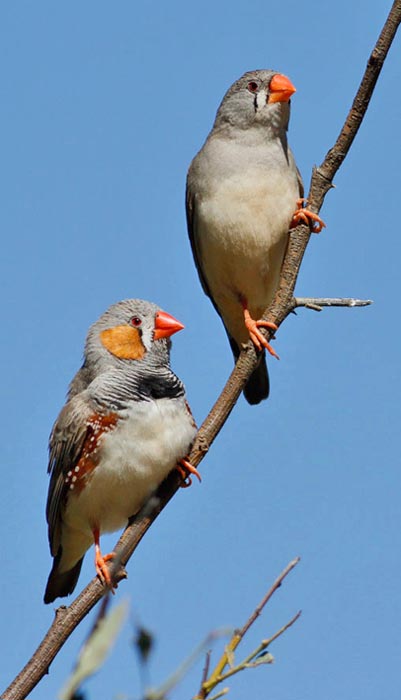 The
Estrildidae are a large family of small finches in the Old World. They
are mostly small seed-eating passerines of open habitats — deserts to
thornscrub to rice paddies and grasslands. There are some, particularly
in arid Australia, in which the adult males are just drop-dead
gorgeous. Some of these are elusive and flighty, like the Painted Finch
(above and below). It is a bird of stony deserts in the Australian
interior, usually near water, and its range expands or contracts with
the presence or absence of water. The mix of males and females (above)
are at a waterhole, but are reluctant to drink because I'm across the
gorge, taking photos.
The
Estrildidae are a large family of small finches in the Old World. They
are mostly small seed-eating passerines of open habitats — deserts to
thornscrub to rice paddies and grasslands. There are some, particularly
in arid Australia, in which the adult males are just drop-dead
gorgeous. Some of these are elusive and flighty, like the Painted Finch
(above and below). It is a bird of stony deserts in the Australian
interior, usually near water, and its range expands or contracts with
the presence or absence of water. The mix of males and females (above)
are at a waterhole, but are reluctant to drink because I'm across the
gorge, taking photos. 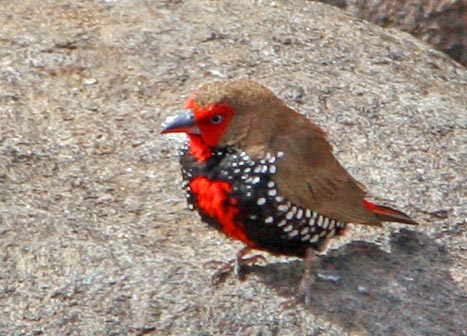
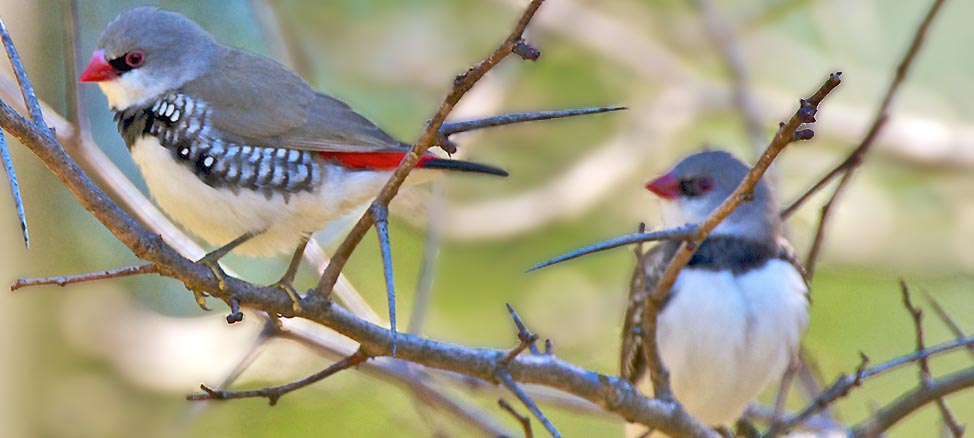
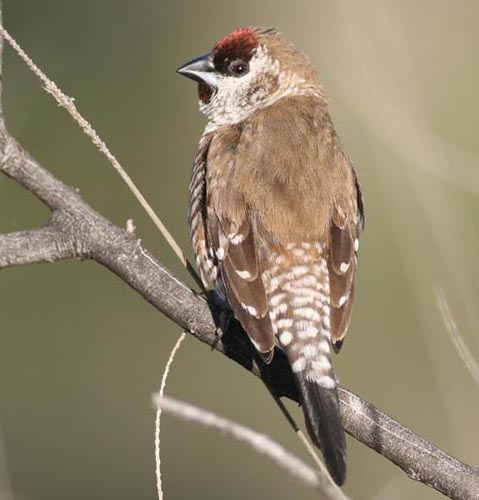
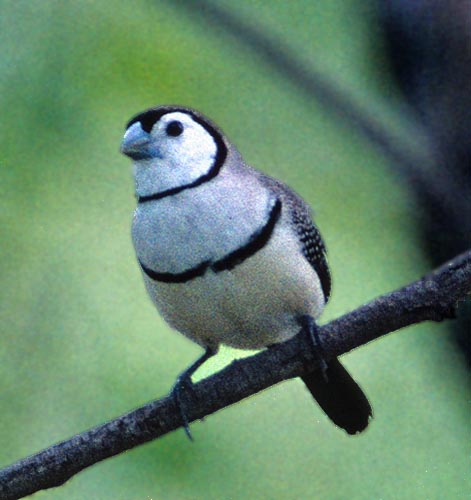
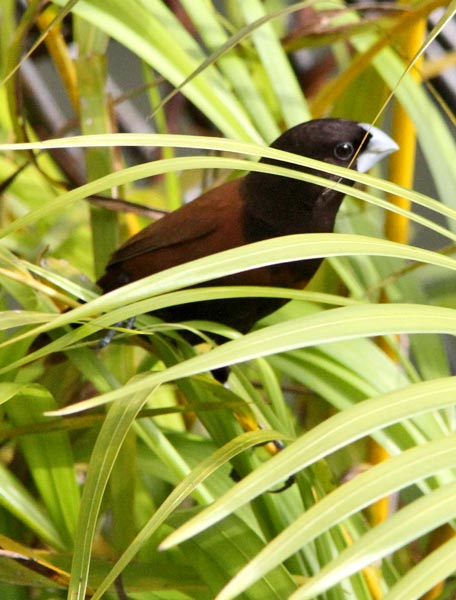 Other lovely Australian "grassfinches" include Plum-headed Finch (above left, a nice Murray Lord shot), of the grassy scrub in eastern Australia, and Double-barred Finch (above right), with its fairly wide range in open eucalypt woodlands of northern and eastern Australia.
Other lovely Australian "grassfinches" include Plum-headed Finch (above left, a nice Murray Lord shot), of the grassy scrub in eastern Australia, and Double-barred Finch (above right), with its fairly wide range in open eucalypt woodlands of northern and eastern Australia. 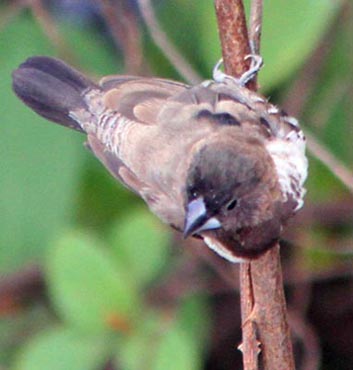
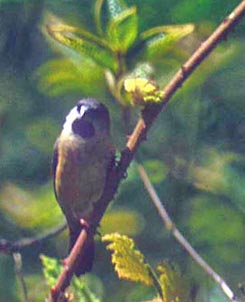
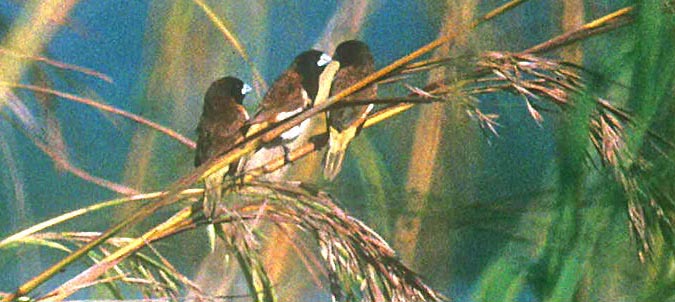
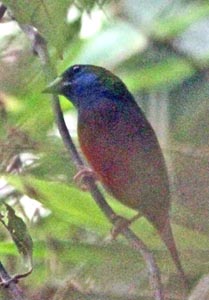
 The second subfamily, per Payne (2005b), is Erythrurine, composed of the Gouldian Finch Erythrura gouldiae
of northern Australia — a very popular cage bird with more in captivity
than in the wild — and 13 species of parrotfinch, including an as-yet
undescribed parrotfinch from Timor. Parrotfinches occur primary in the
Greater Sundas, Philippines, New Guinea, and the islands of Indonesia
and southwestern Pacific. Most (all?) are bamboo specialists.
The second subfamily, per Payne (2005b), is Erythrurine, composed of the Gouldian Finch Erythrura gouldiae
of northern Australia — a very popular cage bird with more in captivity
than in the wild — and 13 species of parrotfinch, including an as-yet
undescribed parrotfinch from Timor. Parrotfinches occur primary in the
Greater Sundas, Philippines, New Guinea, and the islands of Indonesia
and southwestern Pacific. Most (all?) are bamboo specialists. 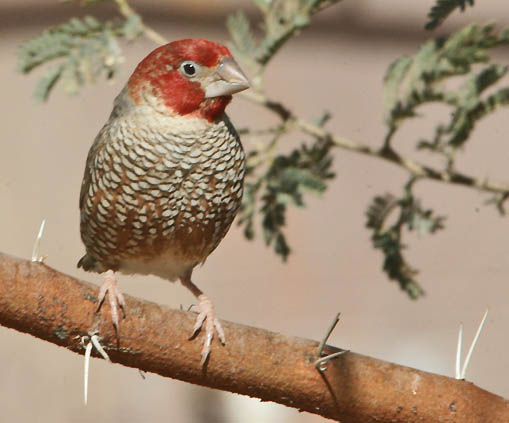 In contrast, the Red-headed Finch
(left) lives in thornscrub deserts in southwestern Africa. You can see
the bristling thorns on the perch. The richly-colored male Violet-eared Waxbill (below) is also a bird of arid open country in southwest Africa.
In contrast, the Red-headed Finch
(left) lives in thornscrub deserts in southwestern Africa. You can see
the bristling thorns on the perch. The richly-colored male Violet-eared Waxbill (below) is also a bird of arid open country in southwest Africa. 

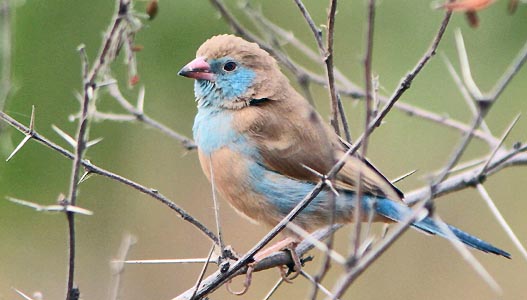
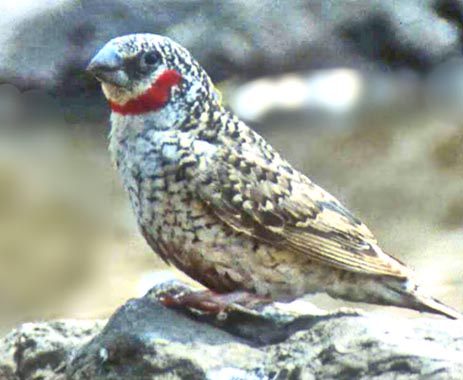 In the arid plains and thornscrub of east Africa, Purple Grenadier Granatina ianthinogaster performs the role taken by Violet-eared Waxbill in the southwest. In those same thickets in east Africa is Blue-capped Condon-bleu (above left). In the Sahel of west Africa, that niche is filled by Red-cheeked Cordon-blue (above
right) — this individual is a female, lacking the red cheek patch but
otherwise similar to the male. More widespread is the Cut-throat Finch
(male shown at right), a dry country species throughout much of
sub-Saharan Africa — from the Sahel to east Africa to northernmost
South Africa.
In the arid plains and thornscrub of east Africa, Purple Grenadier Granatina ianthinogaster performs the role taken by Violet-eared Waxbill in the southwest. In those same thickets in east Africa is Blue-capped Condon-bleu (above left). In the Sahel of west Africa, that niche is filled by Red-cheeked Cordon-blue (above
right) — this individual is a female, lacking the red cheek patch but
otherwise similar to the male. More widespread is the Cut-throat Finch
(male shown at right), a dry country species throughout much of
sub-Saharan Africa — from the Sahel to east Africa to northernmost
South Africa. 